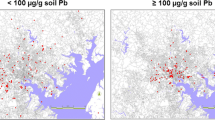Abstract
Lead (Pb) is a toxin that after childhood exposure poses a lifetime of health risks. One route of exposure is soil-Pb as a result of ∼12 million metric tons of Pb residue in paint and gasoline sold in the US during the 20th Century. Pb accumulated in soil of the community is a good predictor for blood Pb of children living there. This retrospective study compares the soil-Pb on Housing Authority of New Orleans (HANO) properties with adjacent private residential (RES) properties within a 0.8 km (0.5 mile) radius. The sample subset (n = 951) is from two soil-Pb surveys (total n = 9,493) conducted between 1989 and 2000. The properties were in both the inner city (CORE) and outlying (OUTER) communities. The data were analyzed using multi-response permutation procedures (MRPP). The soil-Pb results differ significantly (P-value < 0.001) on same-aged HANO properties at different locations; thus, year of construction does not give adequate explanation for the soil-Pb differences. HANO and RES soils are significantly more Pb contaminated in the CORE than in OUTER communities (P-value < 0.001). The CORE has many more years of traffic congestion than OUTER communities; therefore, the lead additives to gasoline, and not lead-based paint, best elucidate the differences of the soil-Pb footprint at HANO and RES properties in the CORE and OUTER communites. Currently HANO properties are being redeveloped with cleaner soil, but soil on RES properties in the CORE of New Orleans remains a large source of Pb (median = 707 mg/kg in this study) for human exposure, especially children.


Similar content being viewed by others
References
Blossom (2005, August) update. Accessed April 10, 2006, from http://www.fort.usgs.gov/products/software/blossom/blossom.asp.
Brown, M. J., & Jacobs, D. E. (2006). Correspondence: Sources of blood lead in children. Environmental Health Perspectives, 114(1), A18–A19.
Canfield, R. L., Henderson, C. R., Jr., Cory-Slechta, D. A., Cox, C., Jusko, T. A., & Lanphear, B. P. (2003). Intellectual impairment in children with blood lead concentrations below 10 μg per deciliter. New England Journal of Medicine, 348, 1517–1526.
Clark, S., Menrath, W., Chen, M., Succop, P., Bornschein, R., Galke, W., & Wilson, J. (2004). The influence of exterior dust and soil lead on interior dust lead levels in housing that had undergone lead-based paint hazard control. Journal of Occupational and Environmental Hygiene, 1, 273–282.
Filippelli, G. M., Laidlaw, M., Latimer, J., & Raftis R. (2005). Urban lead poisoning and medical geology: An unfinished story. Geological Society of America Today, 15, 4–7.
HOPE VI Demolition and Revitalization Grants. http://www.federalgrantswire.com/demolition_and_revitalization_of_severely_distressed_public_housing.html (accessed April 5, 2006).
Jacobs, D., Mielke, H. W., & Pavur, N. (2003). The high cost of improper removal of lead-based paint from housing: A case report. Environmental Health Perspectives, 111, 185–186.
Jartun, M., Ottesen, R. T., & Steinnes, E. (2003). Urban soil pollution and the playfields of small children. Journal Physique IV France, 107, 671–674.
Johnson, D. S., & Bretsch, J. K. (2002). Soil lead and children’s blood lead levels in Syracuse, NY, USA. Environmental Geochemistry and Health, 24(4), 373–385.
Laidlaw, M. A. S., Mielke, H. W., Filippelli, G. M., Johnson, D. L., & Gonzalez, C. R. (2005). Seasonality and children’s blood lead levels: Developing a predictive model using climatic variables and blood lead data from Indianapolis, Indiana, Syracuse, New York and New Orleans, Louisiana (USA). Environmental Health Perspectives, 113(6), 793–800.
Landrigan, P. J., Schechter, C. B., Lipton, J. M., Fahs, M. C., & Schwartz, J. (2002). Environmental pollutants and disease in American children: Estimates of morbidity, mortality, and costs for lead poisoning, asthma, cancer, and developmental disabilities. Environmental Health Perspectives, 110, 721–728.
Lewis, J. (1985). Lead poisoning: A historical perspective. EPA Journal, May 1985 http://www.epa.gov/history/topics/perspect/lead.htm (Accessed February 2, 2007).
Ljung, K., Selinus, O., Otabbong, E., & Berglund, M. (2006). Metal and arsenic distribution in soil particle sizes relevant to soil ingestion by children. Applied Geochemistry, 21(9), 1613–1624.
Mielke, H. W. (1994). Lead in New Orleans soils: New images of an urban environment. Environmental Geochemistry and Health, 16(3/4), 123–128.
Mielke, H. W. (1999). Lead in the inner-cities. American Scientist, 87, 62–73.
Mielke, H. W. (2002). Research ethics in pediatric environmental health: Lessons from lead. Neurotoxicology and Teratology, 24(4), 467–469.
Mielke, H. W. (2005). Lead’s toxic urban legacy and children’s health. Geotimes, 50(5), 22–26.
Mielke, H. W., Adams, J. L., Reagan, P. L., & Mielke, P. W., Jr. (1989). Soil-dust lead and childhood lead exposure as a function of city size and community traffic flow: The case for lead contaminated soil abatement in Minnesota. In Lead in soil: Issues and guidelines (pp. 253–271). Northwood, Britain: Science Reviews, Ltd. (ISBN 0-905927-92-3.).
Mielke, H. W., Anderson, J. C., Berry, K. J., Mielke, P. W., Jr., Chaney, R. L., & Leech, M. (1983). Lead concentrations in inner-city soils as a factor in the child lead problem. American Journal of Public Health, 73(12), 1366–1369.
Mielke, P. W., & Berry, K. J. (2007). Permutation methods: A distance function approach (2nd ed.). New York: Springer-Verlag.
Mielke, H. W., Berry, K. J., Mielke, P. W., Powell, E. T., & Gonzales, C. R. (2005a). Multiple metal accumulation as a factor in learning achievement within various New Orleans communities. Environmental Research, 97(1), 67–75.
Mielke, H. W., Blake, B., Burroughs, S., & Hassinger, N. (1984). Urban lead levels in Minneapolis: The case of the Hmong children. Environmental Research, 34, 64–76.
Mielke, H. W., Dugas, D., Mielke, P. W., Smith, K. S., Smith, S. L., & Gonzales, C. R. (1997). Associations between soil lead and childhood blood lead in urban New Orleans and rural Lafourche Parishes of Louisiana USA. Environmental Health Perspectives, 105, 950–954.
Mielke, H. W., Gonzales, C., Powell, E., & Mielke, P. W., Jr. (2005b). Changes of multiple metal accumulation (MMA) in New Orleans soil: Preliminary evaluation of differences between Survey I (1992) and Survey II (2000). International Journal of Environmental Research and Public Health, 2(2), 84–90.
Mielke, H. W., Gonzales, C. R., Powell, E. T., Shah, A., & Mielke, P. W., Jr. (2002). Natural and anthropogenic processes that concentrate Mn in rural and urban environments of the lower Mississippi River delta. Environmental Research, 90(2), 157–168.
Mielke, H. W., Gonazales, C. R., Smith, C. R., & Mielke, P. W., Jr. (1999). The urban environment and children’s health: soils as an integrator of lead, zinc, and cadmium in New Orleans, Louisiana, USA. Environmental Research, 81, 117–129.
Mielke, H. W., Gonzales, C. R., Smith, M. K., & Mielke, P. W., Jr. (2000). Quantities and associations of lead, zinc, cadmium, manganese, chromium, nickel, vanadium, and copper in fresh Mississippi delta alluvium and New Orleans alluvial soils. Science of the Total Environment, 246, 249–259.
Mielke, H. W., Powell, E. T., Gonzales, C. R., & Mielke, P. W., Jr. (2006b). Hurricane Katrina’s impact on New Orleans soils treated with low lead Mississippi River alluvium. Environmental Science and Technology 40, 7623–7628.
Mielke, H. W., Powell, E. T., Gonzales, C. R., Mielke, P. W., Jr., Ottesen, R. T., & Langedal, M. (2006a). New Orleans soil lead (Pb) cleanup using Mississippi River alluvium: Need, feasibility and cost. Environmental Science and Technology, 40(8), 2784–2789.
Mielke, H. W., Powell, E., Shah, A., Gonzales, C., & Mielke, P. W. (2001). Multiple metal contamination from house paints: Consequences of power sanding and paint scraping in New Orleans. Environmental Health Perspectives, 109, 973–978.
Mielke, H. W., & Reagan, P. L. (1998). Soil is an important pathway of human lead exposure. Environmental Health Perspectives, 106, 217–229.
Needleman, H. L., McFarland, C., Ness, R. B., Fienberg, S. E., & Tobin, M. J. (2002). Bone lead levels in adjudicated delinquents. A case control study. Neurotoxicology and Teratology, 24, 711–717.
Nevin, R. (2000). How lead exposure relates to temporal changes in IQ, violent crime, and unwed pregnancy. Environmental Research, 83, 1–22.
Nriagu, J. O. (1990). The rise, fall of leaded gasoline. Science of the Total Environment, 92, 1–28.
Patterson, C. C. (1980). An alternative perspective—lead pollution in the human environment: Origin, extent, and significance. In Lead in the human environment (pp. 265–349). Washington, DC: National Research Council, National Academy of Sciences. Nation Academy Press.
Rabito, F. A., Shorter, C., & White, L. E. (2003). Lead levels among children who live in public housing. Epidemiology, 14(3), 263–268.
Reagan, P. L. & Silbergeld, E. K. (1989). Establishing a health based standard for lead in residential soils. In D. H. Hemphill & C. R. Cothern (Eds.), Trace substances in environmental health, XXIII, (Suppl. to Vol. 12) Environmental geochemistry and health, pp. 199–238.
Rolfe, G. L., & Haney, A. (1975). An ecosystem analysis of environmental contamination by lead. Urbana, Illinois: Institute for Environmental Studies, University of Illinois at Urbana-Champaign.
Rosner, D., & Markowitz, G. (1985). A ‘gift of god’?: the public health controversy over leaded gasoline during the 1920s. American Journal of Public Health, 75(4):344–352.
Sayer, J. W., Charnery, E., Vostal, J., & Pless, I. B. (1974). House and hand dust as a potential source of childhood lead exposure. American Journal of Disabled Children, 127, 167–170.
Tsaih, S. W., Korrick, S., Schwartz, J., Amarasiriwardena, C., Aro, A., Sparrow, D., & Hu, H. (2004). Lead, diabetes, hypertension, and renal function: The normative aging study. Environmental Health Perspectives, 112(11), 1178–1182.
U.S. EPA. (2001). Lead, identification of dangerous levels of lead, final rule. 40CFR745. Fed. Reg. 2001, 66, 6763–6765.
Acknowledgments
Funding for the soil surveys was provided by grants to Xavier University from the Louisiana Educational Quality and Science Fund (LEQSF) and an Agency for Toxic Substances and Disease Registry/Minority Health Professional Foundation cooperative agreement to Xavier University of Louisiana. A pilot project to test the impact of emplacing clean soil on contaminated property was funded by a U.S. Housing and Urban Development Lead Technical Study to Xavier University of Louisiana. The views expressed in this paper are those of the authors and do not necessarily reflect the positions or policies of the funding agencies.
Author information
Authors and Affiliations
Corresponding author
Rights and permissions
About this article
Cite this article
Mielke, H.W., Gonzales, C., Powell, E. et al. Urban soil-lead (Pb) footprint: retrospective comparison of public and private properties in New Orleans. Environ Geochem Health 30, 231–242 (2008). https://doi.org/10.1007/s10653-007-9111-3
Received:
Accepted:
Published:
Issue Date:
DOI: https://doi.org/10.1007/s10653-007-9111-3




